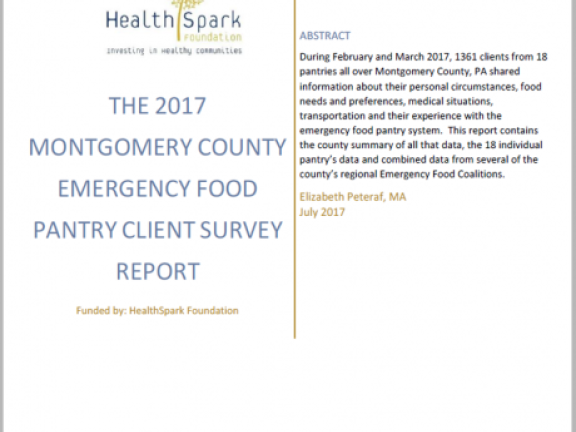Montgomery County Pantry Client Survey Report (2017)

Montgomery County's food pantry network now has the voice of clients from across the entire county to inform positive changes to the network.
Earlier this year, HealthSpark Foundation staff took the lead to create and collect surveys from pantry clients. Although this was the third time a pantry client survey has been conducted since 2014, this year saw the highest number of participating pantries, the most surveys collected and all areas of the county represented. In 2014 and 2015, the survey was conducted almost exclusively in the Norristown area.
The foundation hired consultant Liz Peteraf to lead the project based on her experience in directing the administration of the previous two client surveys. Liz recruited 18 pantries, more than 1/3 of the county's roughly 50 pantries. A total of 1361 surveys were collected from those 18 pantries.
The survey was modified from one created by the Oregon Food Bank and contains questions in the following topics: demographics, housing, employment, access to food and SNAP, health, education, transportation and pantry operations.
Key highlights can be found in Appendix C of the full countywide report, downloadable below.
In addition to the countywide report, each participating pantry received a report with their clients' responses. Additionally, three of the five regional pantry coalitions had enough participating pantries that separate reports were created for each of them.
The data will be used by individual pantries, regional coalitions and the MontCo Anti-Hunger Network Governing Board to continue to improve services and inventory, and provide a more dignified experience for consumers, system-wide.
HealthSpark Foundation thanks Liz, data entry consultant Pam Jones, all participating pantries and each client who generously gave their time to provide this rich data.
MontCo Pantry Client Snapshot
Based on the data collected, the average pantry client in Montgomery County is:
- Female
- Single
- White
- In her early 50s
- Has at least a GED and probably some post-secondary education
- Works part- or full-time
- Is registered to vote
- Likely receives SNAP
- Has a chronic health condition such as high blood pressure


